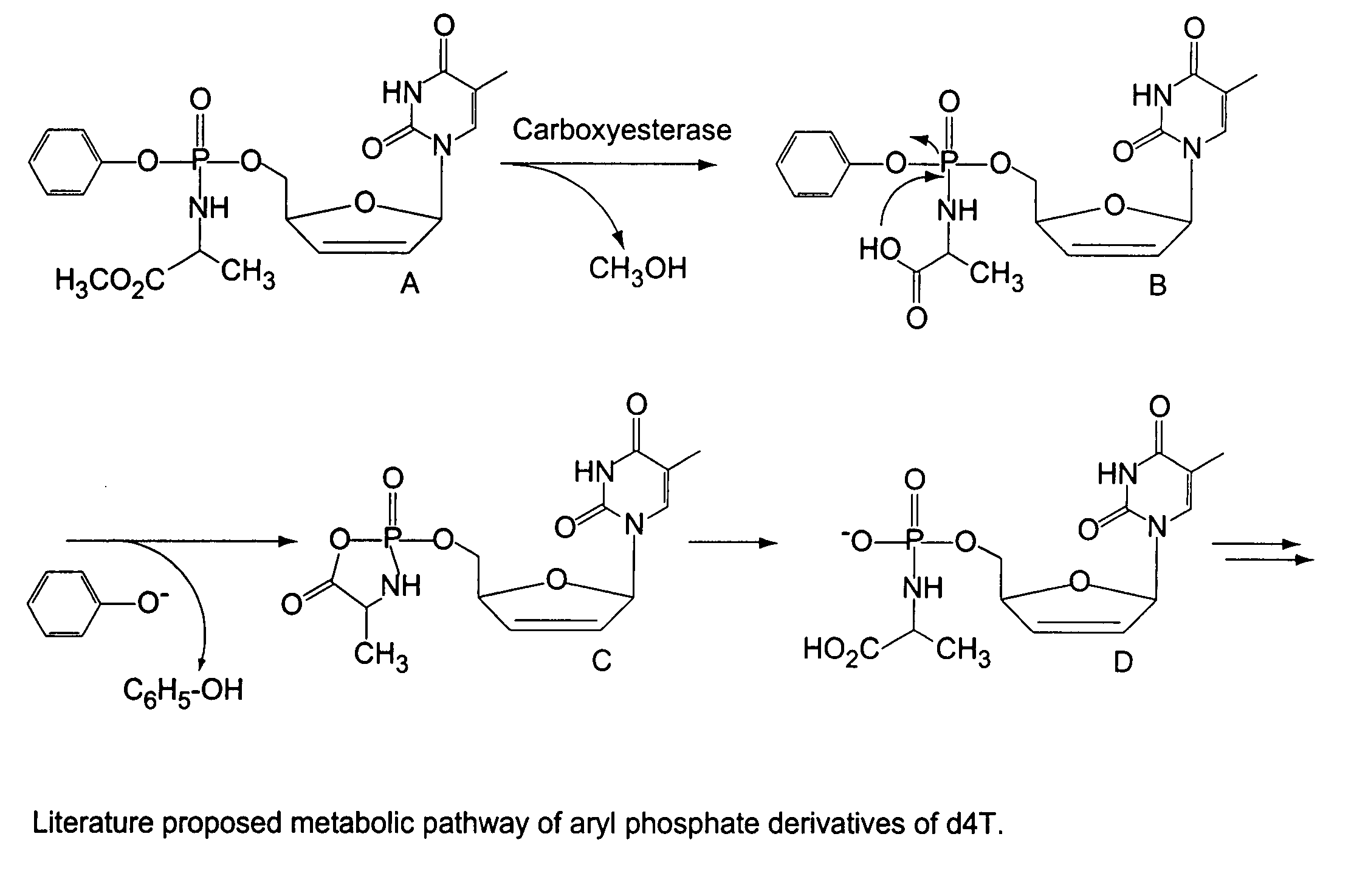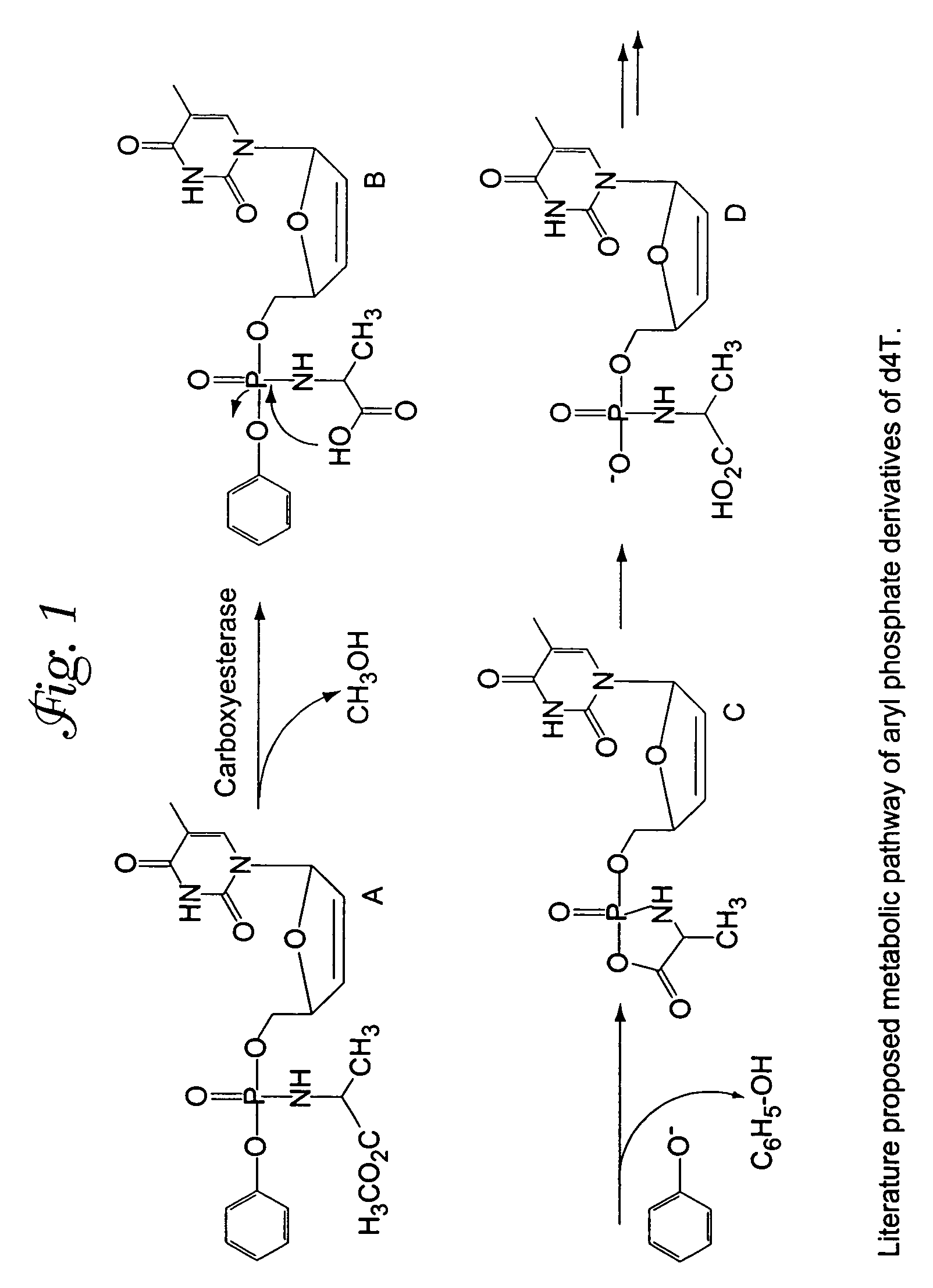Aryl phosphate derivatives of AZT having anti-HIV activity
a technology of aryl phosphate and azt, which is applied in the direction of biocide, group 5/15 element organic compound, drug composition, etc., can solve the problems of ineffective antiviral activity of rtmdr-1 or hiv-2, and achieves moderate activity, increased potency, and potent antiviral activity.
- Summary
- Abstract
- Description
- Claims
- Application Information
AI Technical Summary
Benefits of technology
Problems solved by technology
Method used
Image
Examples
example 1
Synthesis and Characterization of d4T Derivatives
[0024]d4T 1 was prepared from thymidine following the procedure of Mansuri et. al., 1989 J. Med. Chem. 32, 461. Appropriately substituted phenyl methoxyalaninyl phosphorochloridates were also prepared according to the method reported by McGuigan et al 1992 Antiviral Res., 17, 311. Compounds 2–4 were synthesized as outlined below in Scheme 1.
[0025]
Scheme 1. Phenylmethoxyalaninyl phosphorochloridate was added to the solution of d4T and 1-methylimidazole in anhydrous THF and the mixture was stirred at room temperature for 5–6 hours. Work up of the reaction mixture furnished the required derivatives in good yields. Column chromatography was applied to obtain pure compounds.
[0026]Physical data of the synthesized compounds was determined by HPLC was conducted by using C18 4×250 mm LiChrospher column eluted with 70:30 water / acetonitrile at the flow rate of 1 ml / minute. The purity of the following compounds exceeded 96% by HPLC. 13C NMR peaks...
example 3
Susceptibility of Compounds 2–4 to Hydrolysis
[0030]FIGS. 2A and 2B show a schematic representation of the electronic effects of the para substituent in the phenyl ring of metabolite precursor B (see FIG. 1). To assess the susceptibility of compounds to hydrolysis, Compounds 2–4 were dissolved in methanol and then treated with 0.002 N NaOH. The concentrations were kept constant and the generation of the hydrolysis product A-d4T-MP was monitored using HPLC. A Lichrospher column (C18) was used for the HPLC runs. The column was eluted under isocratic conditions using the solvent mixture 70:30 water / acetonitrile, and the elution profile is shown in FIG. 2C.
[0031]Hydrolysis of compounds was tested in a porcine liver esterase system. The data are shown in FIG. 2C. Compounds 2 and 4 (1 mM in Tris-HCl) were incubated with 100 U of porcine liver esterase (Sigma) in Tris-HCl buffer (pH 7.4) for 2 hours at 37° C. Reaction was stopped by adding acetone and chilling the reaction mixture. Followin...
example 4
Intracellular Metabolism of Compounds 2–4 in TK-Deficient CEM Cells
[0034]To analyze the intracellular metabolism of compounds 2–4 in TK-deficient cells, 1×106 CEM cells were incubated with compounds 2–4 (100 μM) for 3 hours and subsequently examined the formation of the partially hydrolyzed phosphate diester metabolite, alaninyl d4T monophosphate by HPLC. Notably, the amount of this metabolite in CEM cells treated with compound 4 was substantially greater than in CEM cells treated with compound 2 or 3 (680 pmol / 106 cells vs 6 cells; FIG. 3).
[0035]CEM cells were cultured in a medium composed of RPMI, 10% fetal bovine serum, and 1% penicillin / streptomycin. Ten million cells at a density of 106 cells / mL were incubated with 100 μM of these compounds for 3 hours at 37° C. After incubation, cells were washed twice with ice-cold PBS, and extracted by addition of 0.5 mL of 60% methanol. Cell lysates were kept at −20° C. overnight, after which lysates were centrifuged at 15000×g for 10 minut...
PUM
| Property | Measurement | Unit |
|---|---|---|
| pH | aaaaa | aaaaa |
| pH | aaaaa | aaaaa |
| detection wavelength | aaaaa | aaaaa |
Abstract
Description
Claims
Application Information
 Login to View More
Login to View More - R&D
- Intellectual Property
- Life Sciences
- Materials
- Tech Scout
- Unparalleled Data Quality
- Higher Quality Content
- 60% Fewer Hallucinations
Browse by: Latest US Patents, China's latest patents, Technical Efficacy Thesaurus, Application Domain, Technology Topic, Popular Technical Reports.
© 2025 PatSnap. All rights reserved.Legal|Privacy policy|Modern Slavery Act Transparency Statement|Sitemap|About US| Contact US: help@patsnap.com



